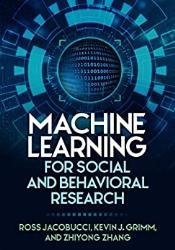Machine Learning for Social and Behavioral Research
- Добавил: literator
- Дата: 11-06-2023, 03:21
- Комментариев: 0
 Название: Machine Learning for Social and Behavioral Research
Название: Machine Learning for Social and Behavioral ResearchАвтор: Ross Jacobucci, Kevin J. Grimm, Zhiyong Zhang
Издательство: The Guilford Press
Год: 2023
Страниц: 435
Язык: английский
Формат: pdf (true)
Размер: 10.27 MB
Today's social and behavioral researchers increasingly need to know: "What do I do with all this data?" This book provides the skills needed to analyze and report large, complex data sets using machine learning tools, and to understand published machine learning articles. Techniques are demonstrated using actual data (Big Five Inventory, early childhood learning, and more), with a focus on the interplay of statistical algorithm, data, and theory. The identification of heterogeneity, measurement error, regularization, and decision trees are also emphasized. The book covers basic principles as well as a range of methods for analyzing univariate and multivariate data (factor analysis, structural equation models, and mixed-effects models). Analysis of text and social network data is also addressed. End-of-chapter "Computational Time and Resources" sections include discussions of key R packages; the companion website provides R programming scripts and data for the book's examples.
While there are various definitions of Machine Learning, we find most of them unsatisfactory, as they refer mainly to concepts from Computer Science. First, we can try to define Machine Learning by the constituent characteristics of the algorithms. For example, we could define Machine Learning as being a family of nonparametric algorithms, meaning that common probability distributions are not used. Thus, p-values, as used in a variety of statistical frameworks (e.g., regression), should not be available in Machine Learning. However, this fails to hold for a number of algorithms, such as Gaussian processing, ridge regression, conditional inference decision trees, and recent algorithms that pair with structural equation models or multi-level models. Second, machine learning as a methodology can be defined by the increase in the degree of complexity compared to traditional statistical models. This definition is difficult to quantify because many algorithms do not have parameters that estimate population level quantities. Further, two methods that fall under the umbrella of machine learning, namely, ridge and lasso regression, go against most attempts to define machine learning in this way because they result in less complex models. Additionally, a number of algorithms, such as support vector machines and neural networks, can be specified to be quite similar to regression models. The most coherent definition of machine learning is a collection of algorithms that are adaptive, meaning the number of parameters, types of constraints, or other characteristics are not set a priori, but are developed during their implementation. Algorithmic flexibility is typically implemented by hyperparameters or tuning parameters, as they are parameters that control various aspects of the algorithm. For instance, the hyperparameters in a random forest, which fits a sequence of decision trees, include the number of trees, tree depth, and the number of variables to test for each split. The drawback to this definition of Machine Learning is that it is seemingly all encompassing, only leaving the generalized linear model as not being Machine Learning.
Скачать Machine Learning for Social and Behavioral Research
[related-news] [/related-news]
Внимание
Уважаемый посетитель, Вы зашли на сайт как незарегистрированный пользователь.
Мы рекомендуем Вам зарегистрироваться либо войти на сайт под своим именем.
Уважаемый посетитель, Вы зашли на сайт как незарегистрированный пользователь.
Мы рекомендуем Вам зарегистрироваться либо войти на сайт под своим именем.
